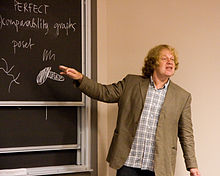János Pach
János Pach (born May 3, 1954 in Hungary ) is a Hungarian mathematician and computer scientist who mainly deals with discrete geometry and geometric graph theory, for which he is considered one of the leading international experts.
Pach is the son of the historian Zsigmond Pál Pach and nephew of the mathematician Pál Turán . He studied at Loránd Eötvös University with a diploma in 1977 and a doctorate under Miklós Simonovits in 1981 (candidate title) ( On Star Systems in Graphs ). He also completed his habilitation (doctorate in the Russian system) in 1995 at the Hungarian Academy of Sciences (Alfred Renyi Institute), where he had been a senior scientist since 1986. In 1991 he became a professor at the Courant Institute of Mathematical Sciences of New York University and in 1992 he became a professor in the Department of Computer Science at City University of New York . He was there from 2004Distinguished Professor . In 2008 he became a professor at the École polytechnique fédérale de Lausanne (EPFL).
He deals with combinatorial and algorithmic geometry and extreme geometric graph theory. He also deals with applications such as motion planning for robots or the design of VLSI computer circuits. He has published over twenty works with Paul Erdős . In 1981 he solved a problem by Stanislaw Ulam by showing that there are no universal countable planar graphs, i.e. no countable planar graphs G, so that every other countable planar graph H is isomorphic to a subgraph of G.
He is invited speaker for the International Congress of Mathematicians 2014 in Seoul (Geometric intersection patterns and the theory of topological graphs). In 1990 he received the Lester Randolph Ford Award . In 2011 he became a Fellow of the Association for Computing Machinery (ACM). In 1982 he received the Géza Grünwald Prize of the Hungarian Mathematical Society (Janos Bolyai Society), the Renyi Prize of the Hungarian Academy of Sciences in 1993 and its Academy Prize in 1998. In 2014 he was elected to the Academia Europaea . He is a Fellow of the American Mathematical Society (2015). In 2020 he will receive an ERC Advanced Grant. He is also the plenary speaker at the 8th European Congress of Mathematicians.
He is co-editor of Discrete and Combinatorial Geometry.
Fonts
- with Pankaj K. Agarwal: Combinatorial Geometry. Wiley 1995.
- with Micha Sharir: Combinatorial Geometry and Its Algorithmic Applications: The Alcalá Lectures. AMS 2009.
- with Peter Brass, WOJ Moser: Research problems in discrete geometry. Springer Verlag 2005.
- Editor: Thirty Essays on Geometric Graph Theory. Springer Verlag 2013.
- Editor: Toward a theory of geometric graphs. AMS 2004.
Some essays:
- A problem of Ulam on planar graphs. European J. Combin. 2, 1981, 357-361.
- with Klara Kedem, Ron Livne, Micha Sharir: On the union of Jordan regions and collision-free translational motion amidst polygonal obstacles. Discrete and Computational Geometry 1, 1986, pp. 59-71.
- with Herbert Edelsbrunner, Leonidas J. Guibas , Richard Pollack, Raimund Seidel, Micha Sharir: Arrangements of curves in the plane: topology, combinatorics, and algorithms. 15th Int. Colloq. Automata, Languages and Programming, Lecture Notes in Computer Science 317, Springer-Verlag, 1992, pp. 214-229.
- with William Steiger, Endre Szemerédi : An upper bound on the number of planar K-sets. Discrete and Computational Geometry 7, 1992, 109-123.
- with Géza Tóth: Graphs drawn with few crossings per edge. Combinatorica 17 ,. 1997, 427-439.
- with Géza Tóth: Which crossing number is it, anyway? Journal of Combinatorial Theory, Series B 80, 2000, 225-246.
- with Hubert de Fraysseix, Richard Pollack: Small sets supporting Fáry embeddings of planar graphs. Proc. 20th ACM Symp. Theory of Computing, 1988, 426-433.
- with R. Wenger: Embedding planar graphs at fixed vertex locations. Graphs and Combinatorics 17, 2001, 717-728.
- with Janos Komlos, Gerhard Woeginger: Almost tight bounds for ε-nets. Discrete & Computational Geometry 7, 1992, 163-173.
- with Gábor Tardos: Tight lower bounds for the size of epsilon-nets. J. Amer. Math. Soc. 26, 2013, 645-658.
Web links
Individual evidence
- ↑ Communication from EPFL on the appointment of Pach
- ^ NSF / CBMS Regional Research Conference in Mathematical Sciences on Geometric Graph Theory. University of North Texas, Denton, 2002, on the history of geometric graph theory and various contributions by Pach.
- ↑ János Pach in the Mathematics Genealogy Project (English)
- ^ For: Jacob Goodman, Janos Pach, Chee K. Yap: Mountain climbing, ladder moving, and the ring-width of a polygon. Amer. Math. Monthly 96 (1989), 494-510.
- ↑ Alice Guionnet and János Pach are this year's recipients of the European Research Council's Advanced Grant , 8th ECM 2020
| personal data | |
|---|---|
| SURNAME | Pach, Janos |
| BRIEF DESCRIPTION | Hungarian mathematician and computer scientist |
| DATE OF BIRTH | May 3, 1954 |
| PLACE OF BIRTH | Hungary |
